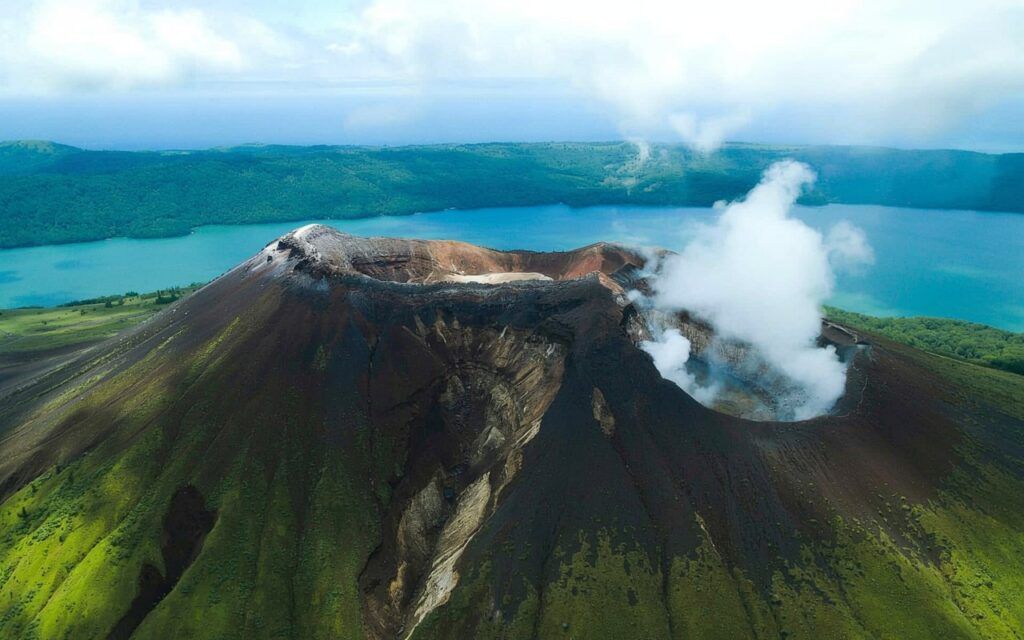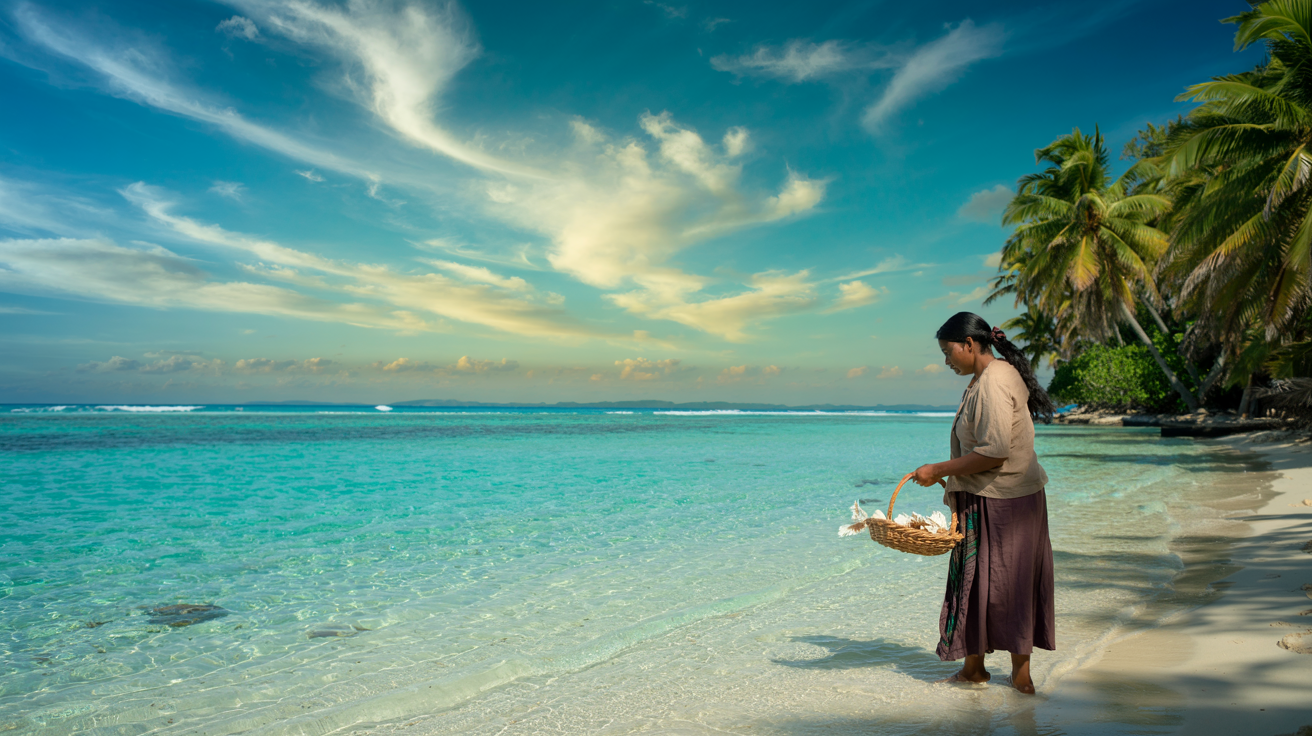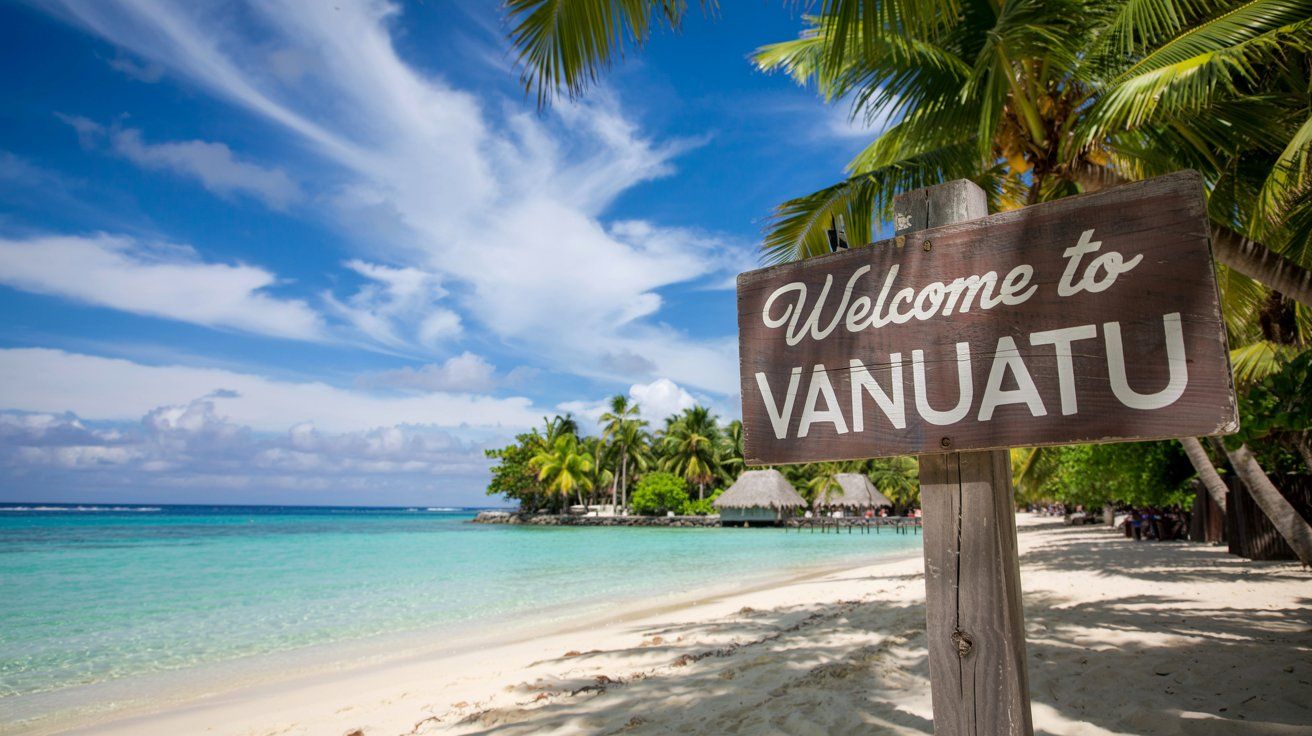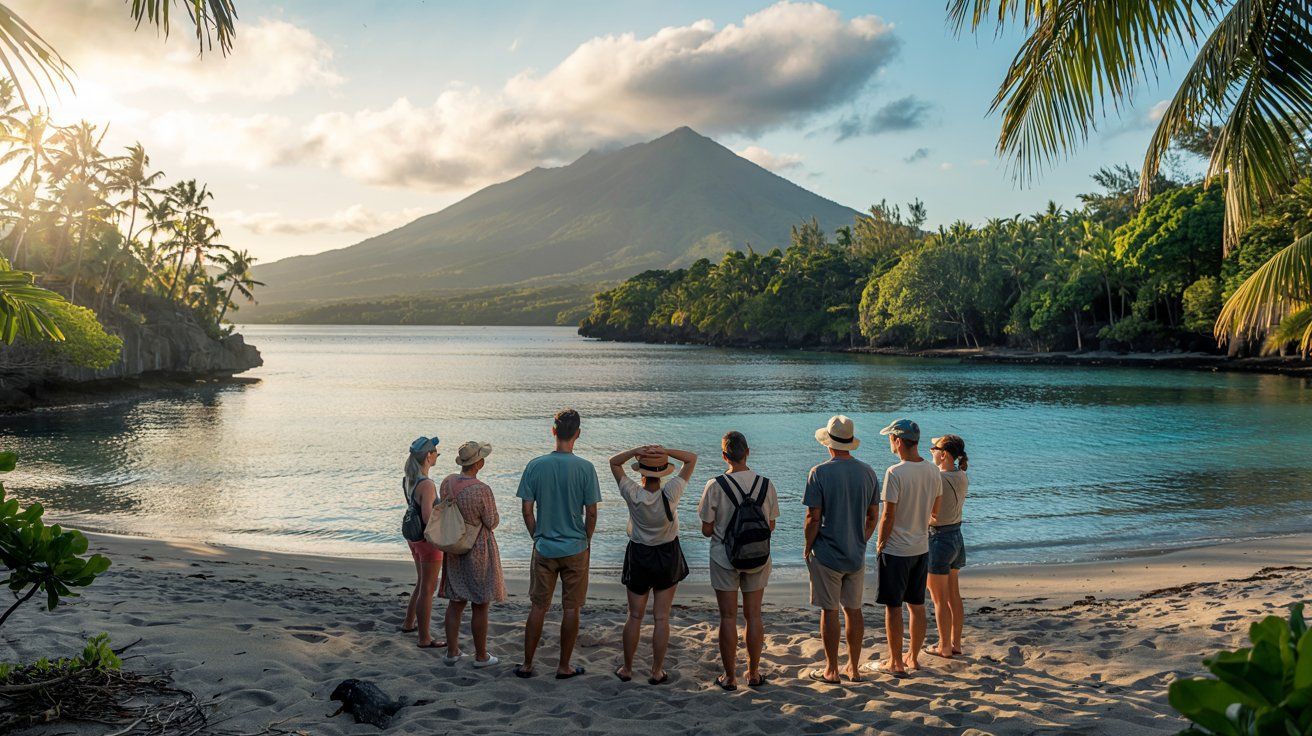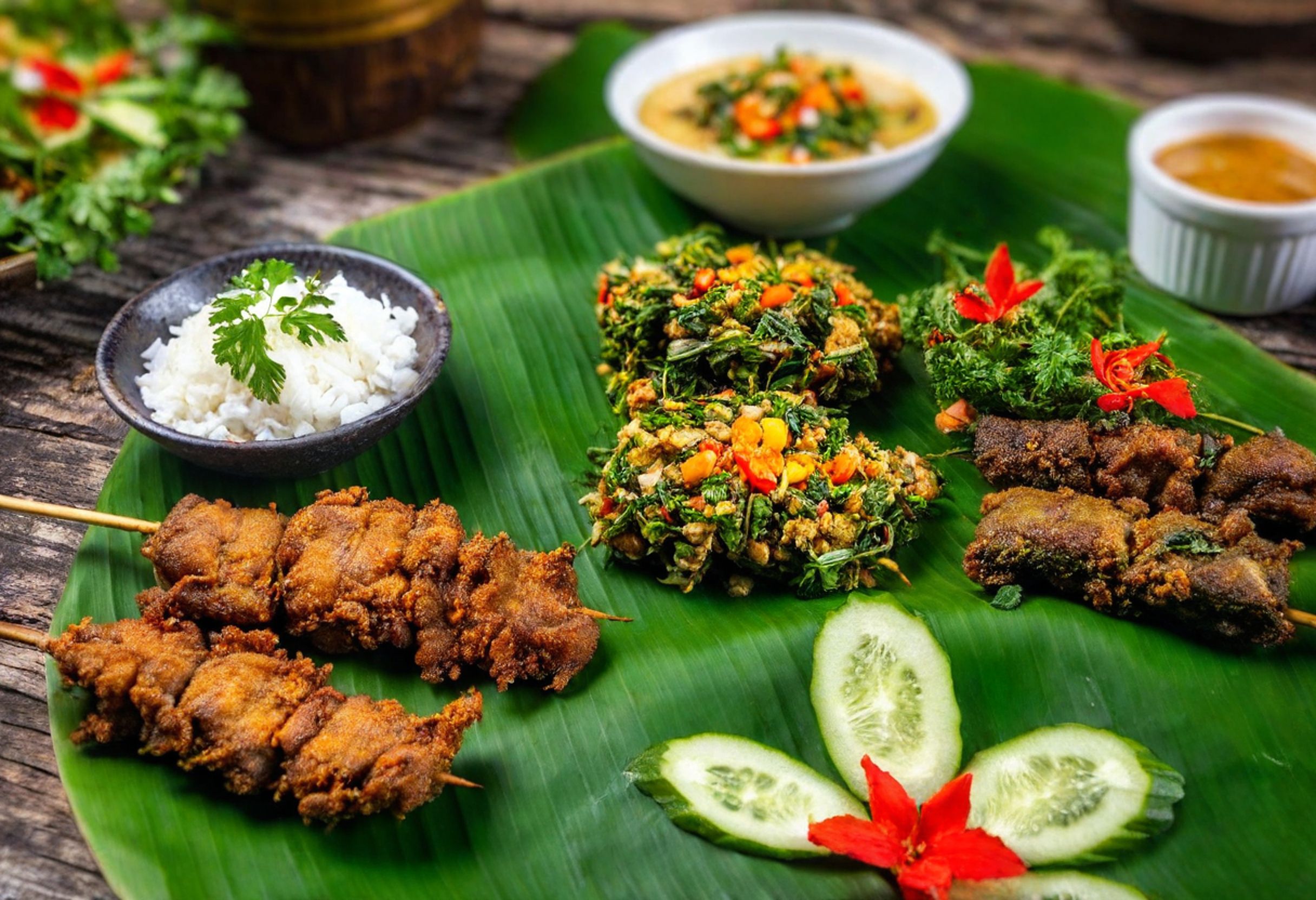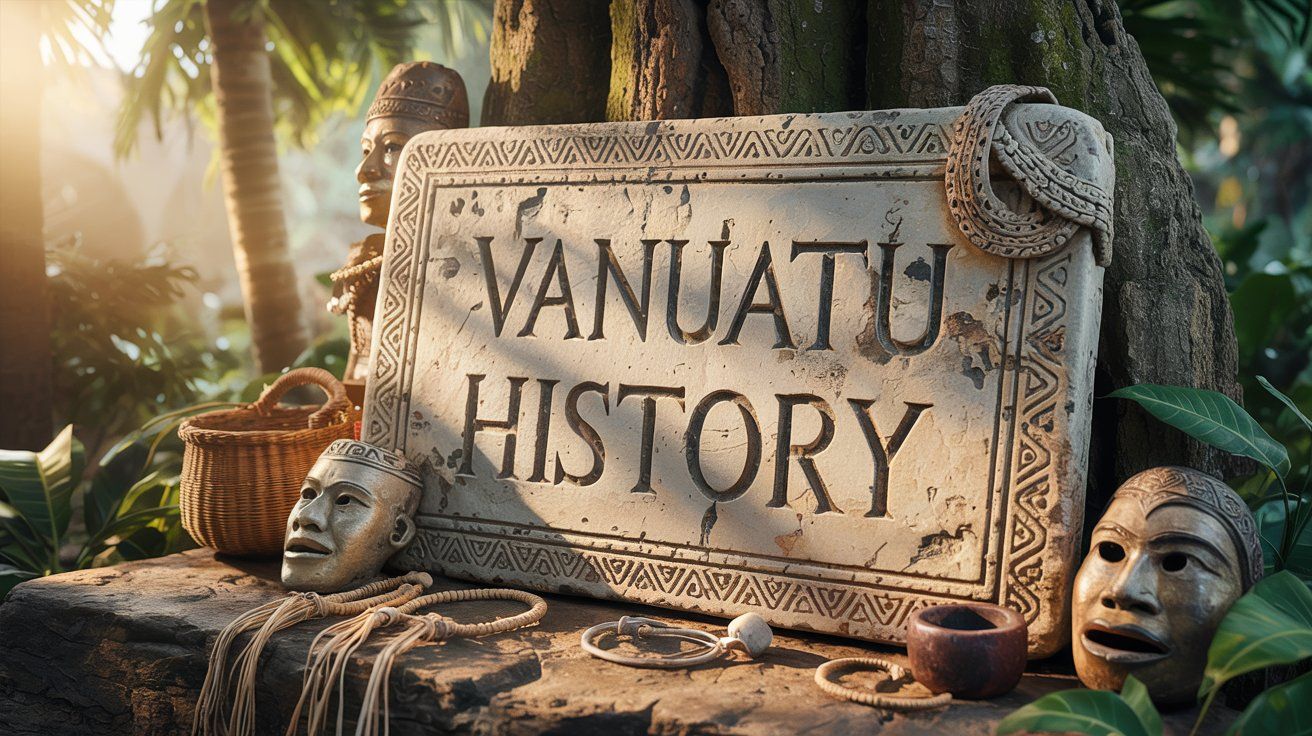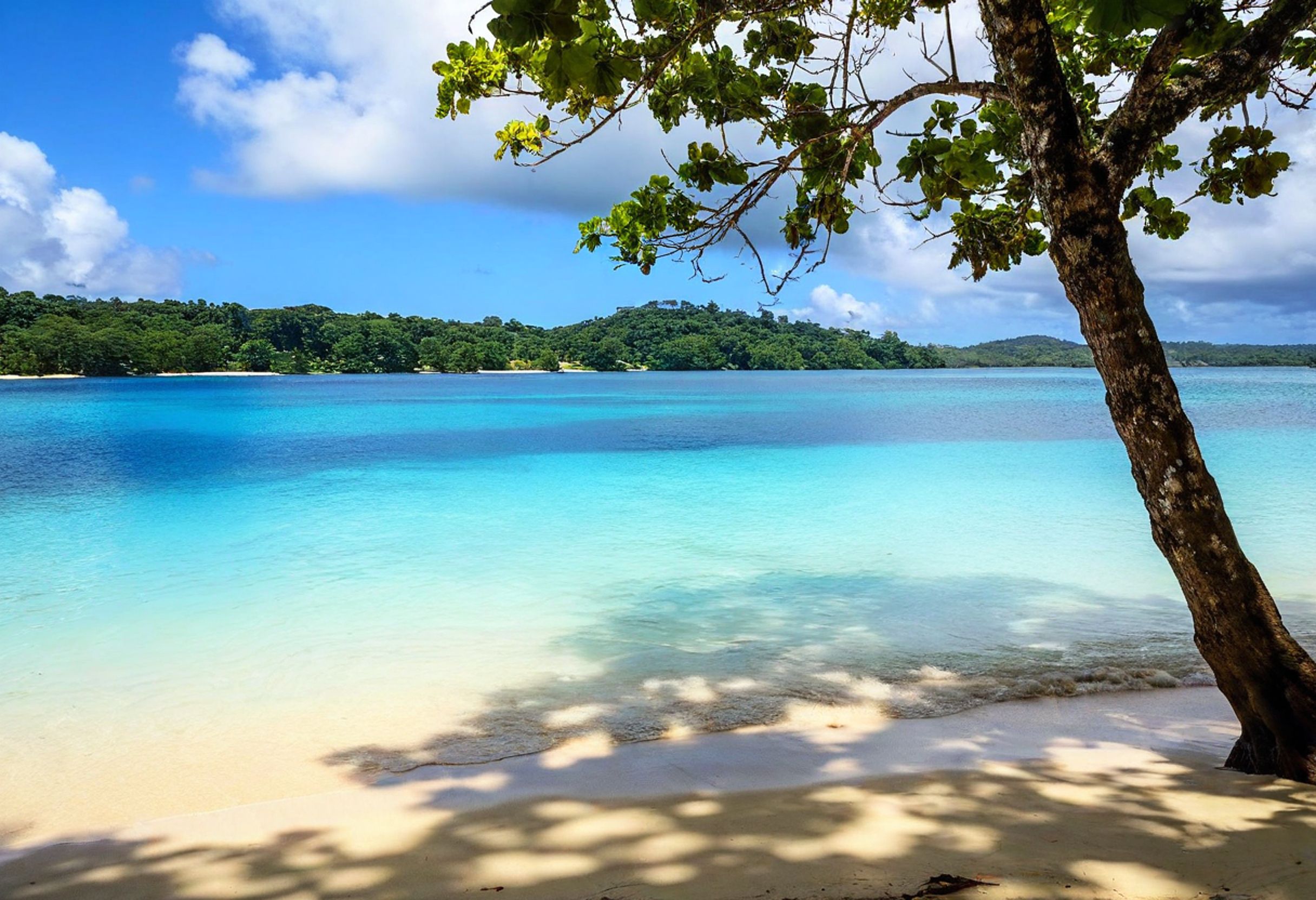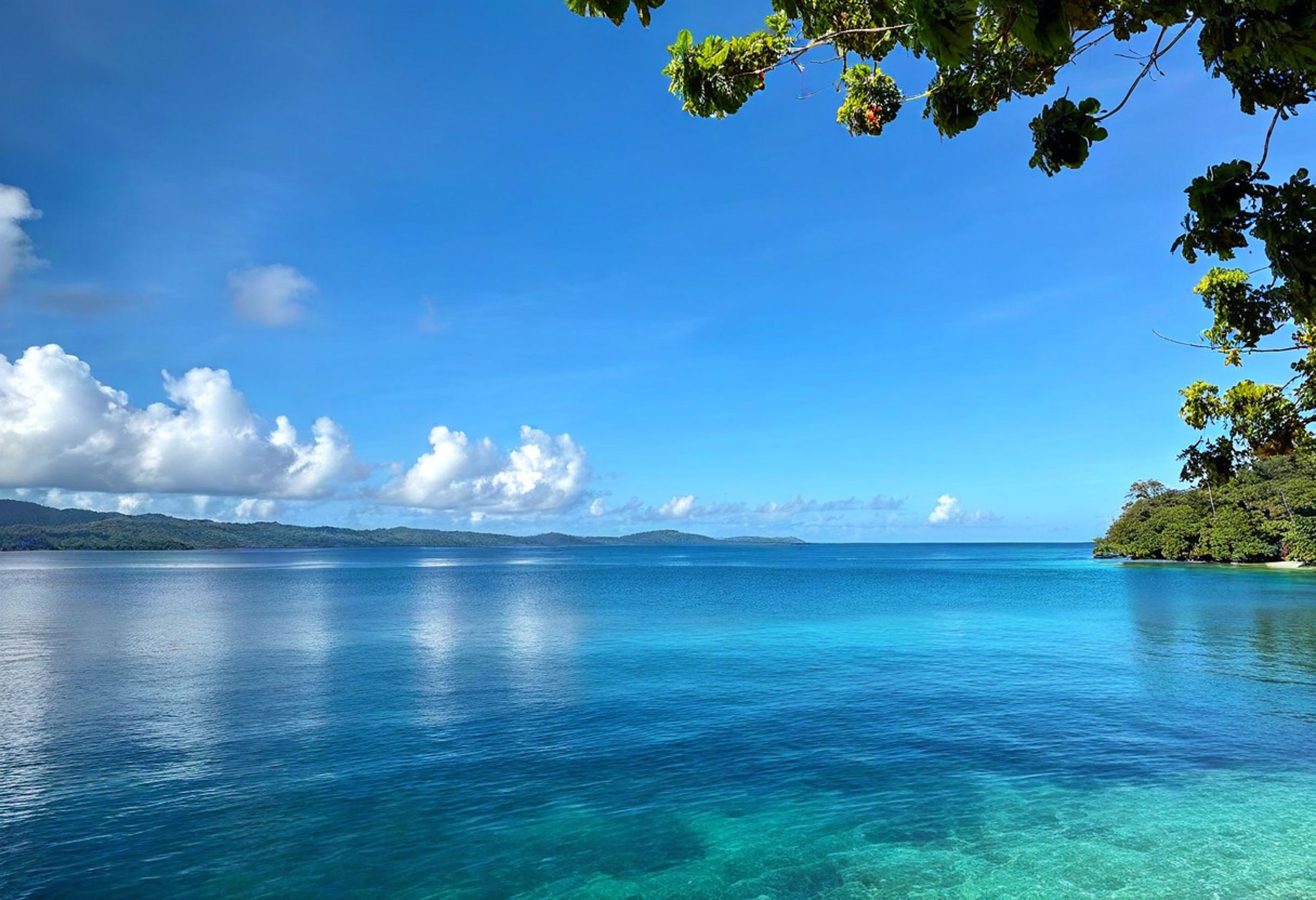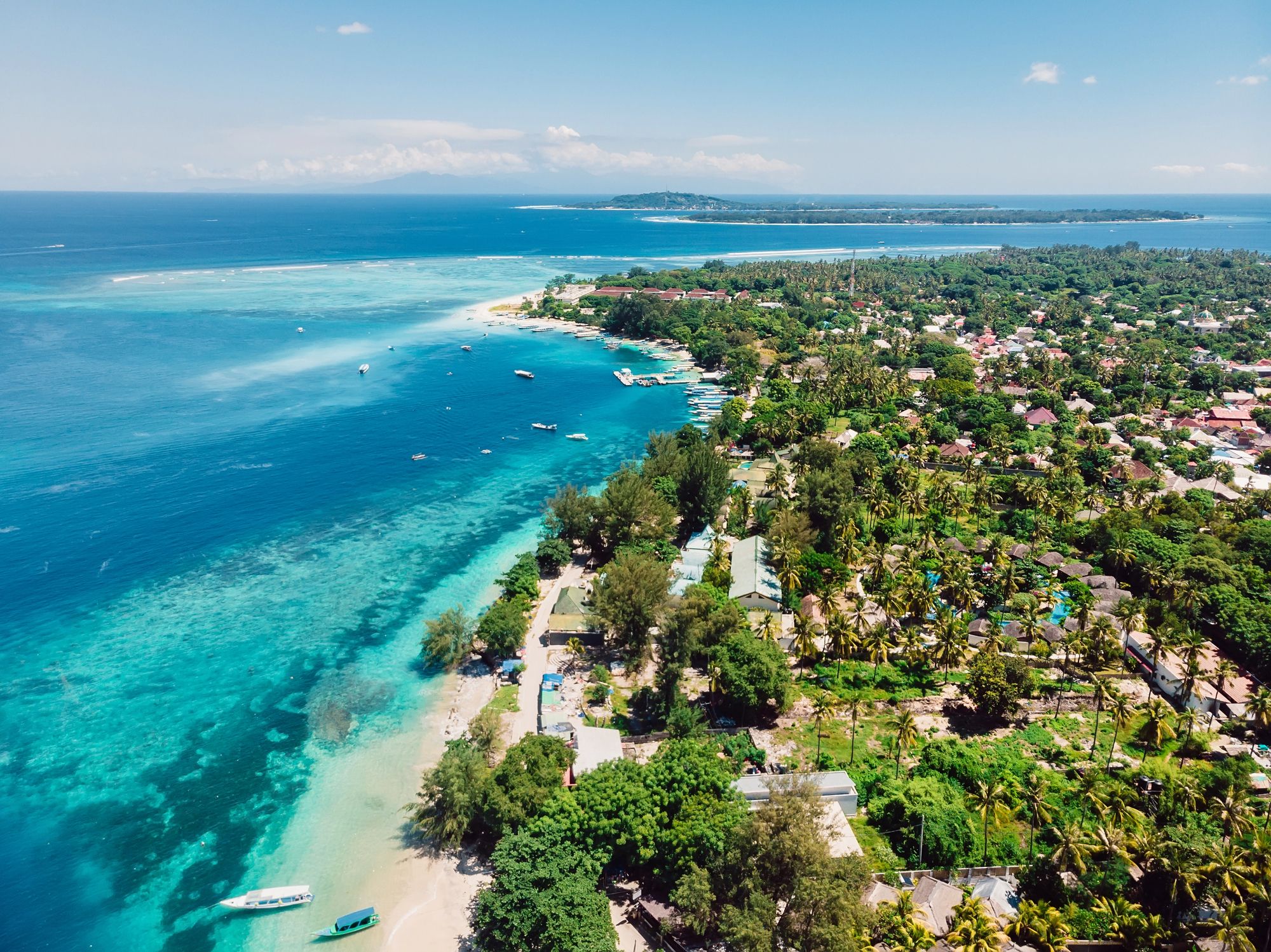Gaua really is one of Vanuatu’s hidden treasures, tucked away in the northern Banks Islands. This rugged island brings together dense jungle, an active volcano, and the highest waterfall in the South Pacific for a destination you won’t soon forget. Come to Gaua and you can hike Mount Garet, swim beneath the dramatic Siri Waterfall, and catch the mesmerizing water music dances local women perform.
When you travel to Gaua, you’re definitely stepping off the usual tourist trail. The island’s humid weather and tough terrain might push your adventurous side, but honestly, the rewards make it all worthwhile. Most travelers end up arranging outrigger canoe trips out to the base of Mount Garet, where Lake Letas wraps around the active volcano in a breathtaking setting.
From overwater bungalows to beachfront resorts, find your perfect stay in this island nation of more than 80 islands. Instant booking with best price guarantee!
Browse Accommodations Now
Gaua’s local culture feels strong and real. Villagers are genuinely friendly and often eager to share their way of life. Sure, accommodation is basic, but the island’s beauty and cultural experiences more than make up for the lack of luxury. You’ll want to plan on staying at least four or five days to really soak in everything this remarkable place has to offer.
Overview of Gaua Island
Gaua Island blends wild natural beauty with authentic culture in northern Vanuatu. The island sits remote and wild, with volcanic landscapes, clean waterways, and traditional Ni-Vanuatu communities living much as they have for generations.
Geography and Location
You’ll find Gaua in Torba Province, northern Vanuatu. At 342 square kilometers, it’s the province’s biggest island. Mount Garet, an active volcano, dominates the landscape and rises straight out of Lake Letas—Vanuatu’s largest lake.
The island’s climate is humid, and thick jungle covers much of the rugged terrain. Siri Waterfall stands out as a highlight, crashing down from Lake Letas with a force you can feel.
Because Gaua sits so far off the beaten path, development hasn’t really touched it. Villages dot the coast, but the interior stays wild. Beaches here are untouched, and coral reefs hug much of the shoreline.
History and Culture
Gaua’s Ni-Vanuatu people keep their traditions alive. Villages across the island pass down customs, including a music tradition that’s totally unique to Gaua.
Local communities love welcoming visitors. Most residents stick to traditional ways—farming, fishing, and living off the land. The island’s isolation has helped keep these cultural roots strong.
Water music, in particular, sets Gaua apart. Women stand in the water and create intricate rhythms by slapping and swirling the surface with their hands.
Life in the villages revolves around community and custom ceremonies. If you visit, you’ll probably get invited to a kava ceremony or see a traditional dance that gives you a window into the island’s past and present.
How to Get to Gaua
Getting to Gaua takes some planning—it’s way up north, and transport options are pretty limited. Flying is by far the easiest way to reach this gem in the Banks Islands.
Traveling from Port Vila
Port Vila acts as the main gateway for international travelers heading to Gaua. From Vila, you’ll need to book a domestic flight with Air Vanuatu. Flights don’t run every day, so check the schedule well in advance.
The flight from Port Vila to Gaua takes about an hour and a half. Plan to depart in the morning from Bauerfield International Airport.
Show up at least an hour before departure. You usually get 10kg for carry-on and 23kg for checked bags.
It’s smart to stay flexible with your plans. Weather, especially during the wet season (November to April), can delay or even cancel flights.
Air Vanuatu Flights
Only Air Vanuatu flies to Gaua Island. Check their website (www.airvanuatu.com) for the latest schedules and fares. Book early—seats go fast.
Flights usually run two or three times a week, often on Mondays, Wednesdays, and Fridays. Expect to pay around 16,000–20,000 VUV ($140–175 USD) one-way.
You’ll likely fly on a Twin Otter or a similar small plane. It’s not fancy, but the views of the islands below are something else.
Keep those weight limits in mind. If you’re bringing special gear like diving equipment, call the airline ahead of time.
You can book online, but sometimes you’ll find extra seats if you call their office directly.
Access from Luganville
Luganville (Santo) offers more frequent flights to Gaua than Port Vila, making it a handy stop if you’re island-hopping.
Flights from Luganville to Gaua take about 40 minutes and usually run three or four times a week.
Because it’s closer, tickets are cheaper—typically 10,000–14,000 VUV ($85–120 USD) one-way.
For the adventurous (and patient), cargo ships sometimes make the trip between Santo and Gaua. The journey takes 8–12 hours and gives you a real taste of local life, though don’t expect much comfort.
Check with the Luganville Tourism Office for the latest shipping info, since schedules change all the time.
Accommodation Options
Gaua has a handful of places to stay, whether you want something eco-friendly or a true village homestay. Most options let you connect with both the local people and the wild landscape.
Eco-Lodges and Resorts
Gaua’s accommodation includes eco-lodges and small resorts that try to balance comfort and caring for the environment. Chez Maureen Bungalows & Tours offers comfy rooms and sometimes throws in guided tours. The bungalows, built with local materials, blend right into the surroundings.
Gateway Lodge gives you a few more amenities without losing that authentic island vibe. Most lodges have private bathrooms, electricity (though sometimes only for a few hours each day), and relaxed communal spaces.
Expect to pay between 3,000–8,000 Vatu ($25–70 USD) per night. Many eco-lodges cook up local dishes, so you’ll get a real taste of Gaua. Booking in advance is a good idea, especially during the busy months from June to September.
Village Stays
If you want to dive deep into island life, village stays are the way to go. Kamilisa Bungalow and Peba Bungalow offer simple, clean rooms run by local families.
These homestays cost around 1,500–3,000 Vatu ($15–25 USD) per night and usually include meals. You’ll sleep in traditional-style bungalows with basic comforts—often shared bathrooms and limited electricity.
The best part? You get to connect with your hosts. They might invite you to join in fishing, gardening, or even cooking. Happiness Bungalow and Dori Lagoon Bungalow are known for their friendly hosts and beautiful waterside locations.
Bring a small gift for your hosts and always respect local customs. Resorts just can’t match the insight into Ni-Vanuatu culture you’ll get from these stays.
Camping on Gaua
Camping is a great way to experience Gaua’s wild side on a budget. There aren’t many formal campgrounds, but you can usually arrange a spot through local guides or village chiefs for a small fee (about 1,000–2,000 Vatu per night).
Popular spots for camping include beaches near Dori Lagoon and around Lake Letas. You’ll need to bring all your own gear from the main islands, since supplies on Gaua are pretty much nonexistent.
Some places, like Rah Bungalows, can help set up camping with a few basic amenities nearby. This style of travel suits those who are self-sufficient and don’t mind roughing it.
Elegant resorts, tropical villas, and vacation rentals with immediate confirmation. Experience a culture dating back to 1,300 BC in this breathtaking archipelago!
See Available Properties
Always get permission from local landowners or chiefs before setting up camp. The reward? Falling asleep to the sound of the ocean or waking up with birdsong in forests that most tourists never see.
Natural Attractions
Gaua packs in some truly wild natural wonders, drawing adventurous travelers from all over. The island’s volcanic core shapes dramatic landscapes you won’t find anywhere else in the South Pacific.
Mt Garet: The Active Volcano
Mt Garet is one of Vanuatu’s most active volcanoes. It rises 797 meters above sea level, often puffing out steam and ash. Sometimes, you’ll spot smoke drifting from the top.
The only way to reach Mt Garet is on a guided trek through thick rainforest. It takes about 4–5 hours one way from the nearest village, so you’ll want sturdy boots and lots of water.
Local guides know the safe spots and share the volcano’s cultural importance. For some villagers, Mt Garet is sacred.
The volcano’s mood changes often. Always check with the Vanuatu Tourism Office before you go, just to make sure it’s safe.
Crater Lake Letas
Lake Letas wraps around Mt Garet and holds the title of Vanuatu’s biggest freshwater lake. It covers about 19 square kilometers and plunges more than 100 meters deep in places.
You can paddle a canoe or kayak out on the lake—locals are happy to help set it up. Depending on the light, the water shifts from deep blue to emerald green.
Birdwatchers, bring your binoculars: the lake is home to unique fish and birds you won’t see anywhere else on Gaua.
A real highlight? Lake Letas feeds the mighty Siri Waterfall, with water spilling out in a dramatic 120-meter drop on the island’s eastern side.
Trekking and Outdoor Activities
Gaua has some of Vanuatu’s best hiking for those who crave adventure and love being out in nature. The landscape is wild and mostly untouched, so you can really lose yourself in it.
Trek to Mt Garet
Mt Garet sits right at the heart of Gaua as an active volcano. Hiking to the top takes you through wild scenery and rewards you with jaw-dropping views. Most guides offer this as a one-day trek, but if you want to take your time, you can stretch it into a multi-day trip.
Start in a local village and arrange for a guide. As you climb, you’ll pass through changing forests before hitting the volcanic slopes. From the summit, Lake Letas spreads out below you.
Wear tough hiking boots and pack plenty of water. Weather can shift fast, so bring rain gear and something warm for the top. Most people say this challenging trek is the highlight of their Gaua adventure.
Rainforest Exploration
Thick rainforests cover most of Gaua, hiding all sorts of rare plants and animals. Trails snake through the jungle, offering glimpses of wildlife and exotic trees.
Guides can point out medicinal plants villagers have used for generations. These rainforest walks usually last a couple of hours and don’t require extreme fitness. Early mornings are best if you want to see birds and butterflies.
Wear light, quick-drying clothes and put on insect repellent. Many guides mix rainforest walks with village visits, so you’ll see how locals live alongside nature.
Visit to Waterfall Bay
Waterfall Bay delivers on its name with the breathtaking Siri Waterfall, plunging 120 meters down volcanic cliffs. The hike there takes about two hours through villages and forest paths.
You’ll spot mist rising from the falls long before you arrive. Bring a waterproof camera—the cascade is something you’ll want to remember. The pool at the bottom is perfect for a cool swim after your walk.
This spot is also famous for the “water music” performed by local women. They create wild rhythms just by moving their hands through the water. If you’re lucky, you’ll catch a performance. The falls are at their most impressive during the wet season.
Snorkeling and Water-Based Adventures
Gaua’s clear waters are a dream for water lovers, with great visibility and plenty of marine life just off the shore. The island’s unique shape means you’ll find good conditions for water adventures pretty much any time of year.
Snorkeling Sites
Gaua’s got some fantastic snorkeling spots where you can swim among colorful coral reefs and all sorts of tropical fish. Along the eastern coast, you’ll find protected coves with calm, shallow water—perfect if you’re new to snorkeling. The soft corals here come in purples and blues, and you’ll spot angelfish and parrotfish darting around.
If you’re a bit more adventurous, head up to the northern beaches. The water gets deeper, and you might catch a glimpse of reef sharks or a sea turtle gliding by. Visibility often stretches past 20 meters up here, which is pretty impressive.
Morning is usually best for snorkeling since the water’s calmer. Local guides know where manta rays like to hang out at certain times of year. Most guesthouses have basic gear, but honestly, bringing your own mask and fins just feels better.
Fishing Excursions
Fishing around Gaua mixes old-school tradition with a bit of modern sport. Local fishermen often invite guests out in small boats for a few hours or even a full day. It’s not just about the catch—you get a real taste of island life.
Close to shore, you can reel in trevally, snapper, and grouper. Want something bigger? Head out to deeper waters for a chance at wahoo or mahi-mahi.
Give hand-line fishing a try—it’s the local way and surprisingly effective. At dawn and dusk, you’ll see locals perched on the shore with nothing but a line and some bait.
Most guides encourage catch-and-release for certain species, keeping things sustainable. If you land something good, they’ll often help arrange for your fish to be cooked up at local restaurants or even right at your guesthouse.
Canoe Experiences
People on Gaua still use traditional outrigger canoes every day, and joining them gives you a glimpse into local life. These sturdy canoes make for a peaceful trip along the coast or out to hidden beaches.
One of the highlights is crossing Lake Letas in an outrigger. It’s Vanuatu’s biggest crater lake, and the journey takes you right to the foot of Mt Garet, the island’s active volcano. Not something you forget in a hurry.
Guided canoe trips usually stop at white sand beaches you can only reach by water. Guides often share stories about the spiritual meaning behind different spots on the island.
Early morning paddles are best—the water’s glassy, and the light’s perfect for photos. Some trips even include camping overnight on remote beaches. There’s something about the steady rhythm of paddling that just pulls you into the moment and makes you feel connected to the Pacific.
Cultural Experiences on Gaua
Gaua Island offers some truly unique cultural encounters you won’t find anywhere else. The Ni-Vanuatu people here are warm and welcoming, especially when it comes to sharing their famous water music performances.
Ni-Vanuatu Traditions
People on Gaua hold tight to their ancestral customs. When you visit a village, expect big smiles and a traditional welcome. Most folks speak Bislama (the national creole), plus their own tribal languages, and many can manage basic English.
Community gatherings, traditional cooking, and handicrafts are at the heart of village life. You can get hands-on with activities like:
- Weaving baskets from pandanus leaves
- Watching food being cooked in earth ovens
- Taking part in evening kava ceremonies
- Hearing about the legends of Mount Garet
If you’re visiting a village, small gifts like school supplies or fishing gear go a long way—much more appreciated than cash.
Water Music Performances
Gaua has this incredible water music tradition, performed only by the women of the island. You really can’t see this anywhere else.
During a show, women wade waist-deep into the water and use their hands to slap, cup, and splash the surface, making surprisingly complex rhythms. The music is mesmerizing—honestly, it’s hard to believe it’s all just water and hands.
Easy booking across stunning accommodations from luxury resorts to eco-friendly retreats. This Y-shaped archipelago offers pristine beaches, active volcanoes, and world-class diving!
Secure Your South Pacific Getaway
Water music means a lot to the community. Locals are now working on copyright protections to help keep the tradition alive.
If you want to see a performance:
- Ask your guesthouse or a local guide to book it
- There’s usually a small fee, which supports the performers
- Bring your camera, but always ask before taking photos
- Set aside 30-45 minutes for the full experience
These shows usually happen near coastal villages, often alongside other cultural displays.
Local Cuisine and Dining
Dining on Gaua is a mix of traditional Ni-Vanuatu cooking and a few French touches. Since the island’s remote, almost everything is fresh and locally grown.
Traditional Foods
Taro, yams, and cassava are the backbone of meals here. Locals wrap these roots in banana leaves and bake them in underground ovens called “nakamals.” The national dish, lap lap, blends grated taro or yam with coconut milk, sometimes with chicken or pork added in.
Coconut is everywhere—people drink the water, cook with the flesh, and use the oil in all sorts of dishes. Producing copra (dried coconut meat) also helps support the island’s economy.
Tropical fruits like mangoes, papayas, and bananas grow all over and show up at nearly every meal. For something different, try kava, the traditional drink made from pepper plant roots.
Seafood Delicacies
Seafood is a big deal on Gaua. Fish gets grilled over open fires or cooked in coconut milk with local herbs.
Lobster is a treat here. Fishermen bring them in fresh every day, and beachside restaurants serve them simply grilled or with French-inspired sauces.
Coconut crab is another specialty—this huge land crab has sweet, rich meat and often gets cooked with garlic and butter, a little nod to French flavors.
Most villages have small, family-run restaurants serving whatever came in that morning. For the freshest picks, hit the morning markets where fishermen sell their catches right off the boat. Many guesthouses can also set up a seafood barbecue on the beach for you—definitely worth doing.
Practical Travel Information
Planning a trip to Gaua takes a bit of work, but it’s worth it. Here’s what you’ll want to know about timing, health, and getting around this remote corner of Vanuatu.
Best Time to Visit
Gaua’s climate is tropical, with a clear wet and dry season. Most people visit during the dry months, May to October, when it rains less and the temperature is more comfortable. Hiking to Lake Letas and Siri Waterfall is much easier then.
From November to April, the wet season brings more humidity, frequent rain, and sometimes cyclones. Some people avoid this period, but you might find cheaper accommodation and see the waterfalls at their most dramatic.
No matter when you go, pack light clothes and something for rain. If you’re hiking to the volcano or waterfalls, start early—clouds tend to roll in later in the day.
Health and Safety Tips
Malaria exists on Gaua, so talk to your doctor about antimalarial meds before you go. Always sleep under a mosquito net and use DEET-based repellent during the day.
You should bring a basic first aid kit—bandages, antiseptic, painkillers, and any personal meds. Health care here is pretty minimal, just basic clinics.
If you’re hiking, always hire a local guide. Trails can get confusing, and the terrain around the volcano is no joke.
Stick to bottled or treated water. Bring purification tablets or a filter, since bottled water isn’t always available.
Essential Services
You won’t find any banks on Gaua. Bring all the cash you’ll need (Vanuatu Vatu) from Port Vila or Santo. There aren’t any ATMs or credit card machines.
Mobile coverage is spotty, but Digicel works best near the main villages. Download maps and important info before you arrive.
Accommodation is pretty basic—think small guesthouses and homestays run by local families. Expect to pay 2,000-4,000 Vatu per night (about $18-36 USD).
Getting around means:
- Walking
- Hiring local guides with boats
- Sometimes catching a truck between villages
Arrange airport pickups ahead of time, since there’s no public transport.
Neighboring Islands and Destinations
Gaua sits among some fascinating islands, and it’s worth adding a few to your Vanuatu adventure. Each one has its own vibe, whether you’re after volcanoes, culture, or just more off-the-grid exploring.
Vanua Lava Island
Vanua Lava lies just north of Gaua in the Banks Islands group. It’s the biggest island in Torba Province, with lush rainforests and hot springs to check out.
Sola, the main village, acts as the provincial capital and has a small airport with flights to Santo. Accommodation is simple but gives you a real taste of local life.
Along the coast, you’ll find black sand beaches and great snorkeling. The island’s interior is still pretty wild, with hiking trails leading to waterfalls and sweeping views.
Local guides can set up cultural activities, from traditional dances to lessons on Banks Islands customs. Getting between Gaua and Vanua Lava usually means a small boat ride, weather permitting.
Ambrym
Ambrym sits to the south and is known for its twin active volcanoes, Mt. Marum and Mt. Benbow. The volcanic landscape feels almost otherworldly, with black sand and ash plains everywhere.
Trekking to the craters is tough—plan for a 1-2 day hike with a local guide, depending on how fit you are and which route you take.
Ambrym is also famous for its rom dance ceremonies and intricate sand drawings, both recognized by UNESCO. Woodcarvers here create stunning tam-tam drums and masks—perfect souvenirs if you ask me.
You’ll find a few guesthouses in villages like Port Vato and Craig Cove. Most people spend at least 3-4 days to really see Ambrym’s volcanoes and culture.
Tanna and Mt Yasur
Tanna sits down in southern Vanuatu and is home to Mt Yasur, one of the world’s most accessible active volcanoes. Watching the nightly eruptions is absolutely unforgettable.
Guided tours take you right up to the crater rim, close enough to feel the ground shake. Dusk is the best time—the lava glows against the dark sky.
Tanna has more to offer:
- Traditional villages where kastom (custom) life is still strong
- The Jon Frum cargo cult community
- Beautiful beaches like Port Resolution
- The Blue Cave, a swimming spot only reachable by boat
To get to Tanna from Gaua, you’ll need to connect via Port Vila. The trip’s a bit of a trek, but totally worth it if you want to see Mt Yasur and explore the island for a few days.
Malekula, Ambae, and Ureparapara
Malekula is Vanuatu’s second-largest island and is packed with cultural traditions. The Small Nambas and Big Nambas tribes each have their own customs, and you can experience them by staying in a village.
Ambae, or “Volcano Island,” made headlines when the Manaro volcano erupted in 2017-2018. Some folks have returned, but there’s not much tourism infrastructure yet.
Ureparapara, way up in the Torres Islands, has a dramatic horseshoe-shaped bay from an ancient volcanic crater. Hardly any tourists make it out here, so it’s ideal if you’re after something really off the beaten path.
Each island’s got its own flavor:
- Malekula: Mask-making and dance ceremonies
- Ambae: Lake Voui in the volcanic crater (if it’s accessible)
- Ureparapara: Untouched beaches and traditional sailing
Getting between these islands and Gaua usually means a mix of small planes and boats, and schedules can be, well, flexible.
Art and Handicrafts
Gaua’s artistic traditions reflect its deep cultural heritage and strong ties to nature. Local craftspeople make unique items that aren’t just souvenirs—they help support the community too.
Wood Carvings
Gaua artisans really know how to bring wood to life, crafting detailed sculptures that capture stories from island life and ancient beliefs. Walk around the island and you’ll spot carvings of ancestral figures, local animals, and spiritual symbols just about everywhere. Some are small enough to fit in your palm, while others take up a whole corner of a room.
Carvers pick their wood from local trees, choosing each type for its unique qualities. They tend to grab darker hardwoods for the really intricate designs, and lighter woods when they want something that pops or contrasts a bit more.
A lot of these artists still reach for the old tools and techniques their families taught them. If you decide to buy, keep an eye out for the “Vanuatu Made” label—it’s the best way to make sure you’re getting the real deal and actually helping out the local artists.
Traditional Art Forms
Beyond wood carving, Gaua bursts with traditional arts that really highlight local creativity. Woven products stand out, especially since the skilled “mamas” (women) make baskets, mats, and bags from pandanus leaves and other natural fibers.
Weavers here stick to techniques that are unique to their village or even their own family. The patterns and designs aren’t just pretty—they often hold cultural meaning or share a bit of island life in their own way.
Find available hotels and vacation homes instantly. No fees, best rates guaranteed!
Check Availability Now
You’ll spot colorful textiles everywhere, with plant-based dyes bringing out vibrant blues, reds, and yellows. Hand-painted pieces usually show off island scenery, wildlife, or scenes from traditional ceremonies.
At the Port Vila Markets, vendors bring in a wide range of authentic Gaua handicrafts. But honestly, if you want the best picks and a chance to meet the artists themselves, head to a village craft cooperative. Sometimes you can even catch them working on new pieces right in front of you.

